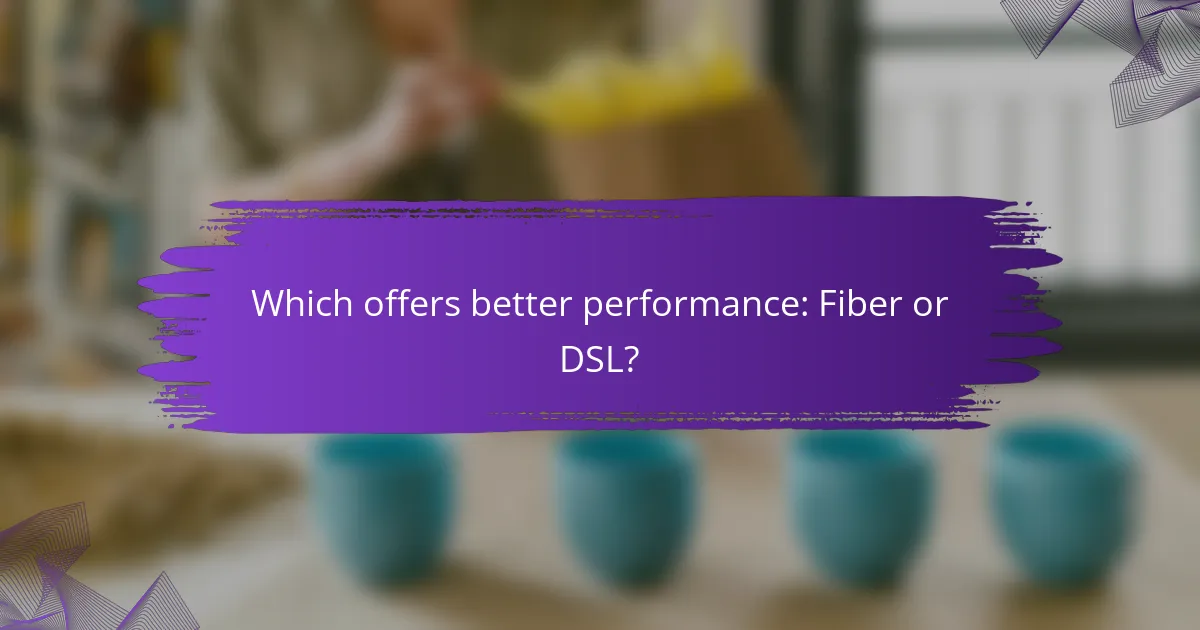When comparing internet options, fiber and DSL stand out for their distinct performance characteristics. Fiber technology utilizes light signals for data transmission, resulting in faster speeds and greater reliability compared to DSL, which relies on copper wires. While fiber generally provides superior performance, it often comes at a higher price, making DSL a more budget-friendly choice for those with basic internet needs.

Which offers better performance: Fiber or DSL?
Fiber generally offers better performance than DSL, particularly in terms of speed and capacity. While DSL can be sufficient for basic internet needs, fiber’s superior technology provides faster and more reliable connections.
Fiber provides higher speeds
Fiber optic internet can deliver speeds ranging from hundreds of megabits per second (Mbps) to several gigabits per second (Gbps). This is significantly faster than DSL, which typically offers speeds from a few megabits to around 100 Mbps, depending on the distance from the service provider’s central office.
The high speeds of fiber are ideal for activities such as streaming high-definition video, online gaming, and large file downloads. For households with multiple users, fiber ensures that everyone can use the internet simultaneously without noticeable slowdowns.
DSL offers lower latency
DSL connections generally have lower latency compared to fiber, which can be beneficial for real-time applications like video conferencing and online gaming. Latency in DSL can be in the range of 20 to 50 milliseconds, while fiber may experience slightly higher latency due to the technology used.
However, the difference in latency may not be significant for most users, especially if they prioritize speed and bandwidth over response time. For casual browsing and streaming, both options perform adequately.
Fiber supports more devices
Fiber internet can handle a larger number of connected devices without compromising performance. This is particularly important in smart homes where multiple devices, such as smartphones, tablets, and smart TVs, are connected simultaneously.
DSL, on the other hand, may struggle with multiple devices, leading to slower speeds and reduced performance as more users connect. If you have a busy household or run a home office, fiber is the better choice for ensuring consistent connectivity.
DSL is widely available
DSL is often more widely available than fiber, particularly in rural and underserved areas. Many regions have established DSL infrastructure, making it accessible to a larger number of households.
While fiber is expanding rapidly, it may not yet be available in all locations. If you live in a rural area, DSL might be your only option for high-speed internet. Always check local service providers to determine the best available options for your specific location.

What are the key differences between Fiber and DSL?
Fiber and DSL differ primarily in their technology and performance capabilities. Fiber optic connections use light signals for data transmission, while DSL relies on copper wires, leading to significant differences in speed and reliability.
Fiber uses light signals
Fiber optic technology transmits data using light signals through glass or plastic fibers. This method allows for faster data transfer rates and greater capacity compared to traditional copper wiring. Fiber connections can support high-speed internet plans, often exceeding 1 Gbps, making them ideal for bandwidth-intensive activities like streaming and gaming.
DSL uses copper wires
DSL (Digital Subscriber Line) technology utilizes existing copper telephone lines to deliver internet service. While it can provide decent speeds, typically ranging from a few Mbps to around 100 Mbps, its performance is limited compared to fiber. The quality of the copper lines and the distance from the provider’s central office can significantly impact DSL speeds.
Fiber has higher bandwidth
Fiber connections generally offer much higher bandwidth than DSL, enabling multiple devices to connect simultaneously without a noticeable drop in speed. This is particularly beneficial for households with many users or for businesses that require reliable, high-speed internet for operations. Fiber’s bandwidth capabilities can easily accommodate modern demands for streaming, video conferencing, and online gaming.
DSL is more affected by distance
DSL performance is heavily influenced by the distance between the user and the service provider’s central office. As the distance increases, the signal degrades, leading to slower speeds and potential connectivity issues. In contrast, fiber optic signals maintain their strength over much longer distances, providing consistent performance regardless of location.

How do Fiber and DSL compare in pricing?
Fiber and DSL differ significantly in pricing, with fiber generally being more expensive due to its advanced technology and higher performance capabilities. DSL offers more budget-friendly options, making it appealing for users who prioritize cost over speed.
Fiber typically costs more
Fiber internet plans usually range from moderate to high monthly fees, often starting around $50 and going up to $100 or more, depending on the speed and provider. The higher cost reflects the superior speed and reliability fiber offers, making it suitable for heavy internet users or households with multiple devices.
When considering fiber, it’s essential to evaluate your internet usage needs. If you frequently stream high-definition content, play online games, or work from home, the investment in fiber may yield better performance and satisfaction.
DSL offers budget-friendly options
DSL internet plans are typically more affordable, with prices often ranging from $20 to $60 per month. This makes DSL a practical choice for users who need basic internet access for browsing and light streaming without breaking the bank.
However, while DSL is cost-effective, it may not provide the same speed or reliability as fiber, especially in areas with poor infrastructure. Users should assess their internet needs and consider whether the lower cost of DSL aligns with their usage patterns.

What factors should you consider when choosing between Fiber and DSL?
When choosing between Fiber and DSL, consider availability, speed needs, and budget. Each factor significantly impacts performance and user experience, making it essential to evaluate them based on your specific situation.
Availability in your area
Availability is a crucial factor since not all regions have access to both Fiber and DSL services. Fiber networks are often limited to urban and suburban areas, while DSL can be found in more rural locations. Check local providers to see which options are available to you.
To find out what services are offered in your area, visit provider websites or use online tools that compare internet options based on your address. This will help you understand your choices and avoid frustration later on.
Speed requirements for your household
Your household’s speed requirements will dictate which service is more suitable. Fiber typically offers much higher speeds, often exceeding 1 Gbps, making it ideal for multiple users streaming, gaming, or working from home. DSL, on the other hand, usually provides speeds ranging from 1 to 100 Mbps, which may suffice for basic browsing and streaming on a few devices.
Assess your internet usage patterns. If you have several devices connected simultaneously or engage in high-bandwidth activities, Fiber is likely the better choice. For lighter usage, DSL may meet your needs effectively.
Budget constraints
Budget is an important consideration when selecting between Fiber and DSL. Fiber services tend to be more expensive, with monthly costs often ranging from $50 to $100 or more, depending on speed and provider. DSL plans are generally more affordable, typically costing between $20 and $60 per month.
Evaluate your budget against your speed needs. If you require high speeds but have a limited budget, consider looking for promotional offers or bundled services that may provide better value. Always read the fine print to avoid unexpected fees.

What are the advantages of Fiber over DSL?
Fiber offers several advantages over DSL, primarily in speed and reliability. With fiber-optic technology, users experience significantly faster internet connections and a more stable performance, making it ideal for high-demand activities like streaming and gaming.
Faster download and upload speeds
Fiber connections typically provide download speeds ranging from hundreds of megabits per second to several gigabits per second, while DSL speeds usually max out in the low hundreds of megabits per second. This means that fiber can handle multiple devices streaming or downloading simultaneously without a noticeable drop in performance.
Additionally, fiber offers symmetrical upload and download speeds, which is crucial for activities like video conferencing or uploading large files. In contrast, DSL often has slower upload speeds, which can hinder productivity for users who need to send data quickly.
More reliable connection
Fiber-optic cables are less susceptible to interference from environmental factors, such as electrical noise or weather conditions, compared to DSL, which relies on copper lines. This results in a more consistent and reliable internet connection, especially in areas with fluctuating weather or heavy electrical usage.
Moreover, fiber networks can maintain high performance over longer distances without signal degradation, unlike DSL, which can experience reduced speeds as the distance from the service provider increases. This reliability makes fiber a preferred choice for businesses and households that require uninterrupted internet access.
